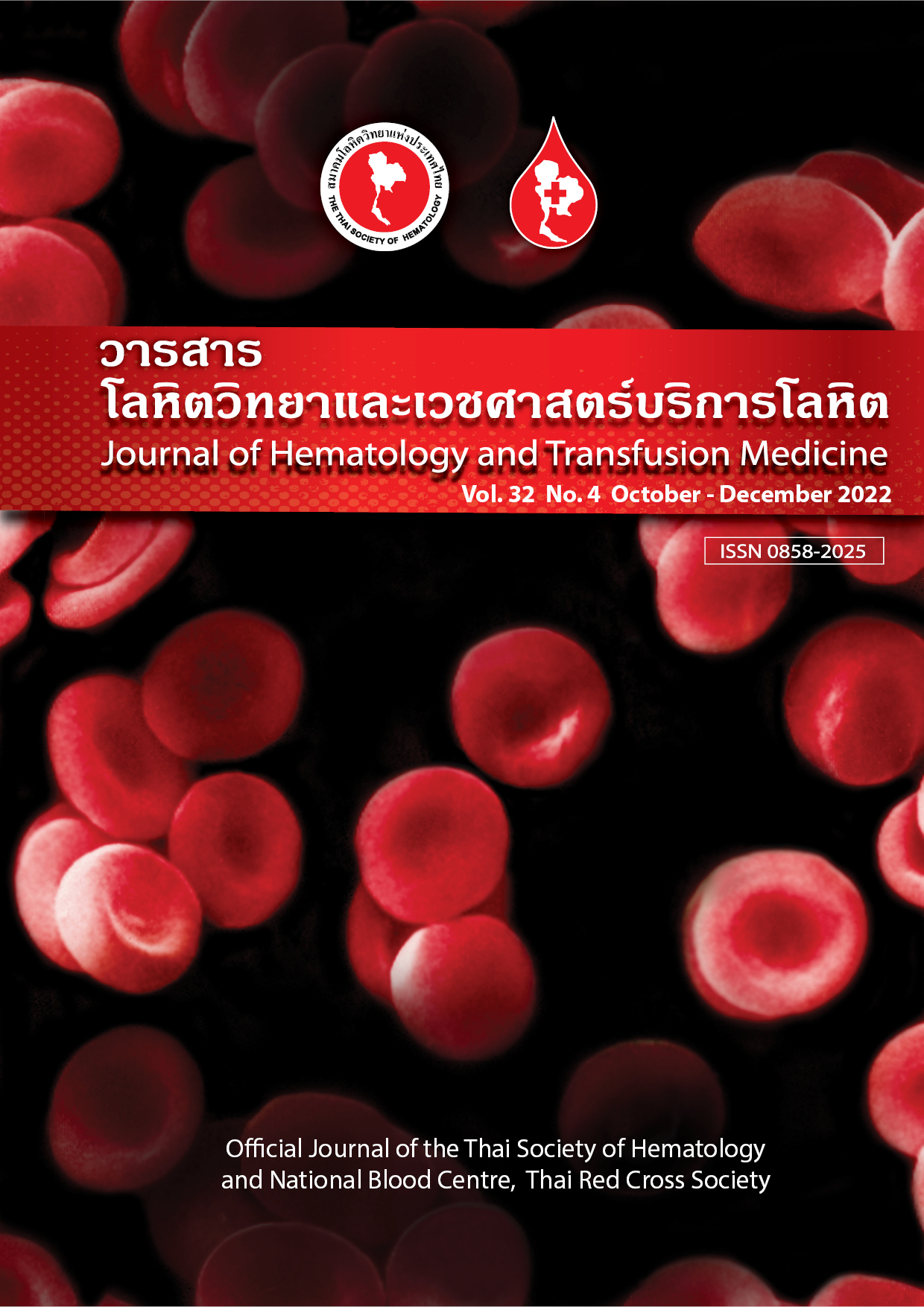Calculation of fresh frozen plasma amount to correct high international normalized ratio
Keywords:
Fresh frozen plasma, INR, FormulaAbstract
Introduction: Fresh frozen plasma (FFP) is the most widely-used blood component to correct high International
Normalized Ratio (INR). However, little is known about the amount of FFP needed to correct high INR and factors
related to normalized INR. Methods: A retrospective chart review study included 144 patients (96 warfarin and 48
nonwarfarin groups), aged over 18 years old, presenting high pretransfusion INR (PreINR; > 1.5) and receiving FFP
with INR values after transfusion (PostINR) between September 1, 2019 and November 30, 2020. ΔINR (PreINR
- PostINR) was calculated. Results: The median (range) PreINR was 2.67 (1.50-14.64) and median (range) ΔINR
was 0.87 (-0.09-12.81). The mean (±SD) amount of FFP was 2.2±0.6 units. The median (range) time from FFP
administration to PostINR testing was 4.59 hours (0-19). The median (range) time between PreINR and PostINR
testing was 11.55 hours (3-33). Vitamin K was administered to 88 patients. The formula ΔINR after FFP 2 units
= (0.91 x PreINR)-1.38 (R2 = 0.96 between predicted INR and actual improvement INR; p < 0.001). The factors,
correlated with normalized PostINR (INR < 1.5), were lower PreINR level (adjusted odds ratio [aOR] = 0.64, p =
0.017), intravenous vitamin K (aOR = 1.74, p = 0.025) and longer duration between PreINR and PostINR testing
(aOR = 1.30, p = 0.001). Conclusion: This formula may be used to predict INR after FFP transfusion. Factors
correlated with normalized INR after transfusion were lower pretransfusion INR, intravenous vitamin K and longer
duration between pre- and posttransfusion INR measurements
Downloads
References
O’Shaughnessy DF, Atterbury C, Maggs PB, Murphy M, Thomas D, et al. Guidelines for the use of fresh-frozen plasma, cryoprecipitate and cryosupernatant. Br J Haematol. 2004;126:11-28.
Rashidi A, Tahhan HR. Fresh frozen plasma dosing for warfarin reversal: a practical formula. Mayo Clin Proc. 2013;88:244-50.
Sezik S, Aksay E, Kılıç TY. The Effect of Fresh Frozen Plasma Transfusion on International Normalized Ratio in Emergency Department Patients. J Emerg Med. 2014;47:596-600.
Yang L, Stanworth S, Hopewell S, Doree C, Murphy M. Is fresh frozen plasma clinically effective? An update of a systematic review of randomized controlled trials (CME). Transfusion. 2012;52;1673-86.
Shinagare SA, Angarkar NN, Desai SR, Naniwadekar MR. An audit of fresh frozen plasma usage and effect of fresh frozen plasma on the pre-transfusion international normalized ratio. Asian J Transfus Sci. 2010;4:128-32.
Stanworth SJ, Grant-Casey J, Lowe D, Laffan M, New H, Murphy MF, et al. The use of fresh frozen plasma in England: high levels of inappropriate use in adults and children. Transfusion. 2011;51:62-70.
Wallis Jp, Dzik S. Is fresh frozen plasma overtransfused in the United States? Transfusion. 2004;44:1674-5.
Canadian Medical Association. Expert Working Group. Guidelines for red blood cell and plasma transfusion for adults and children. CMAJ. 1997;156(Suppl 11):S1-4.
Abdel-Wahab OI, Healy B, Dzik WH. Effect of fresh-frozen plasma transfusion on prothrombin time and bleeding in patients with mild coagulation abnormalities. Transfusion. 2006;46:1279-85.
Tomaselli GF, Mahaffey KW, Cuker A, Dobesh PP, Doherty JU, Eikelboom JW, et al. 2020 ACC expert consensus decision pathway on management of bleeding in patients on oral anticoagulants: a report of the American college of cardiology solution set oversight committee. J Am Coll Cardiol. 2020;76:594-622.
Frazee LA, Bouguet CC, Gutierrez W, Elder-Arrington J, Elackattu AEP, Haller NA. Retrospective evaluation of a method to predict fresh-frozen plasma dosage in anticoagulated patients. Am J Ther. 2008;15:111-8.
Holland LL, Brooks JP. Toward rational fresh frozen plasma transfusion; the effect of plasma transfusion on coagulation test results. Am J Clin Pathol. 2006;126:133-9.
Downloads
Published
Issue
Section
License
Copyright (c) 2022 Journal of Hematology and Transfusion Medicine

This work is licensed under a Creative Commons Attribution-NonCommercial-NoDerivatives 4.0 International License.



